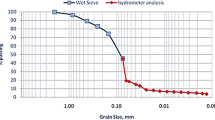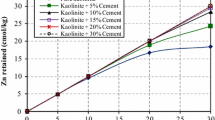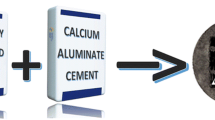Abstract
Cement-based stabilization/solidification (S/S) is a practical treatment approach for hazardous waste with anthropogenic As sources; however, its applicability for geogenic As-containing soil and the long-term leaching potential remain uncertain. In this study, semi-dynamic leaching test was performed to investigate the influence of S/S binders (cement blended with fuel ash (FA), furnace bottom ash (FBA), or ground granulated blast furnace slag (GGBS)) on the long-term leaching characteristics of geogenic As. The results showed that mineral admixtures with higher Ca content and pozzolanic activity were more effective in reducing the leached As concentrations. Thus, cement blended with FBA was inferior to other binders in suppressing the As leaching, while 20% replacement of ordinary Portland cement by GGBS was considered most feasible for the S/S treatment of As-containing soils. The leachability of geogenic As was suppressed by the encapsulation effect of solidified matrix and interlocking network of hydration products that were supported by scanning electron microscopy (SEM), X-ray diffraction (XRD), and X-ray photoelectron spectroscopy (XPS) results. The long-term leaching of geogenic As from the monolithic samples was diffusion-controlled. Increasing the Ca content in the samples led to a decrease in diffusion coefficient and an increase in feasibility for “controlled utilization” of the S/S-treated soils.









Similar content being viewed by others
References
Ali I, Al-Othman ZA, Alwarthan A, Asim M, Khan TA (2014) Removal of arsenic species from water by batch and column operations on bagasse fly ash. Environ Sci Pollut Res 21:3218–3229
Beiyuan J, Awad YM, Beckers F, Tsang DCW, Ok YS, Rinklebe J (2017a) Mobility and phytoavailability of As and Pb in a contaminated soil using pine sawdust biochar under systematic change of redox conditions. Chemosphere 178:110–118
Beiyuan J, Li JS, Tsang DCW, Wang L, Poon CS, Li XD, Fendorf S (2017b) Fate of residual arsenic after chemical-enhanced washing of an arsenic-containing soil in Hong Kong. Sci Total Environ 599-600:679–688
Beiyuan J, Tsang DCW, Valix M, Zhang W, Yang X, Ok YS, Li XD (2017c) Selective dissolution followed by EDDS washing of an e-waste contaminated soil: extraction efficiency, fate of residual metals, and impact on soil environment. Chemosphere 166:489–496
Bisone S, Chatain V, Blanc D, Gautier M, Bayard R, Sanchez F, Gourdon R (2016) Geochemical characterization and modeling of arsenic behavior in a highly contaminated mining soil. Environ Earth Sci 75:1–9
Bolan N, Mahimairaja S, Kunhikrishnan A, Seshadri B, Thangarajan R (2015) Bioavailability and ecotoxicity of arsenic species in solution culture and soil system: implications to remediation. Environ Sci Pollut Res 22:8866–8875
Camacho J, Wee HY, Kramer TA, Autenrieth R (2009) Arsenic stabilization on water treatment residuals by calcium addition. J Hazard Mater 165:599–603
Chakraborti D, Rahman MM, Ahamed S, Dutta RN, Pati S, Mukherjee SC (2016) Arsenic groundwater contamination and its health effects in Patna district (capital of Bihar) in the middle Ganga plain, India. Chemosphere 152:520–529
Chakraborty S, Weindorf DC, Deb S, Li B, Paul S, Choudhury A, Ray DP (2017) Rapid assessment of regional soil arsenic pollution risk via diffuse reflectance spectroscopy. Geoderma 289:72–81
Clancy TM, Snyder KV, Reddy R, Lanzirotti A, Amrose SE, Raskin L, Hayes KF (2015) Evaluating the cement stabilization of arsenic-bearing iron wastes from drinking water treatment. J Hazard Mater 300:522–529
Drahota P, Filippi M, Ettler V, Rohovec J, Mihaljevič M, Šebek O (2012) Natural attenuation of arsenic in soils near a highly contaminated historical mine waste dump. Sci Total Environ 414:546–555
Du YJ, Wei ML, Reddy KR, Liu ZP, ** F (2014) Effect of acid rain pH on leaching behavior of cement stabilized lead-contaminated soil. J Hazard Mater 271:131–140
Dutré V, Vandecasteele C (1998) Immobilization mechanism of arsenic in waste solidified using cement and lime. Environ Sci Technol 32:2782–2787
Fendorf S, Michael HA, van Geen A (2010) Spatial and temporal variations of groundwater arsenic in South and Southeast Asia. Science 328:1123–1127
Gwenzi W, Mupatsi NM (2016) Evaluation of heavy metal leaching from coal ash-versus conventional concrete monoliths and debris. Waste Manag 49:114–123
Halim CE, Amal R, Beydoun D, Scott JA, Low G (2004) Implications of the structure of cementitious wastes containing Pb(II), Cd(II), As(V), and Cr(VI) on the leaching of metals. Cem Concr Res 34:1093–1102
Hernandez-Bautista E, Bentz DP, Sandoval-Torres S, Cano-Barrita PDJ (2016) Numerical simulation of heat and mass transport during hydration of Portland cement mortar in semi-adiabatic and steam curing conditions. Cem Concr Compos 69:38–48
HK EPD (2011) Practice guide for investigation and remediation of contaminated land. Environmental Protection Department, Hong Kong
Karak T, Abollino O, Bhattacharyya P, Das KK, Paul RK (2012) Fractionation and speciation of arsenic in three tea gardens soil profiles and distribution of As in different parts of tea plant (Camellia sinensis L.) Chemosphere 85:948–960
Kim EJ, Yoo JC, Baek K (2014) Arsenic speciation and bioaccessibility in arsenic-contaminated soils: sequential extraction and mineralogical investigation. Environ Pollut 186:29–35
Kim EJ, Lee JC, Baek K (2015) Abiotic reductive extraction of arsenic from contaminated soils enhanced by complexation: arsenic extraction by reducing agents and combination of reducing and chelating agents. J Hazard Mater 283:454–461
Leist M, Casey RJ, Caridi D (2003) The fixation and leaching of cement stabilized arsenic. Waste Manag 23:353–359
Li JS, Poon CS (2017) Innovative solidification/stabilization of lead contaminated soil using incineration sewage sludge ash. Chemosphere 173:143–152
Li JS, Xue Q, Wang P, Li ZZ, Liu L (2014) Effect of drying-wetting cycles on leaching behavior of cement solidified lead-contaminated soil. Chemosphere 117:10–13
Li JS, Xue Q, Wang P, Wang HQ, Zhang TT (2016) Evaluation of leaching characteristics of heavy metals from municipal solid waste incineration fly ash by up-flow percolation column tests. Environ Earth Sci 75:1–10
Li JS, Beiyuan J, Tsang DCW, Wang L, Poon CS, Li XD, Fendorf S (2017) Arsenic-containing soil from geogenic source in Hong Kong: leaching characteristics and stabilization/solidification. Chemosphere 182:31–39
Malviya R, Chaudhary R (2006) Leaching behavior and immobilization of heavy metals in solidified/stabilized products. J Hazard Mater 37:207–217
Moon DH, Wazne M, Yoon IH, Grubb DG (2008) Assessment of cement kiln dust (CKD) for stabilization/solidification (S/S) of arsenic contaminated soils. J Hazard Mater 159:512–518
Phenrat T, Marhaba TF, Rachakornkij M (2007) XRD and unconfined compressive strength study for a qualitative examination of calcium–arsenic compounds retardation of cement hydration in solidified/stabilized arsenic-iron hydroxide sludge. J Environ Eng 133:595–607
Rahman MS, Reichelt-Brushet AJ, Clark MW, Farzana T, Yee LH (2017) Arsenic bio-accessibility and bioaccumulation in aged pesticide contaminated soils: a multiline investigation to understand environmental risk. Sci Total Environ 581-582:782–793
Randall PM (2012) Arsenic encapsulation using Portland cement with ferrous sulfate/lime and Terra-Bond™ technologies—microcharacterization and leaching studies. Sci Total Environ 420:300–312
Sima J, Cao X, Zhao L, Luo Q (2015) Toxicity characteristic leaching procedure over-or under-estimates leachability of lead in phosphate-amended contaminated soils. Chemosphere 138:744–750
Singh TS, Pant KK (2006) Solidification/stabilization of arsenic containing solid wastes using Portland cement, fly ash and polymericmaterials. J Hazard Mater 131:29–36
Singh R, Singh S, Parihar P, Singh VP, Prasad SM (2015) Arsenic contamination, consequences and remediation techniques: a review. Ecotox Environ Safe 112:247–270
Song F, Gu L, Zhu N, Yuan H (2013) Leaching behavior of heavy metals from sewage sludge solidified by cement-based binders. Chemosphere 92:344–350
Stea F, Bianchi F, Cori L, Sicari R (2014) Cardiovascular effects of arsenic: clinical and epidemiological findings. Environ Sci Pollut Res 21:244–251
Subalakshmi P, Saraswathy V, Sivasankaran SK (2012) Hydraulicity of mineral admixtures in cement blends. Constr Build Mater 36:648–653
Tsang DCW, Yip ACK (2014) Comparing chemical-enhanced washing and waste-based stabilisation approach for soil remediation. J Soils Sediments 14:936–947
Tsang DCW, Olds WE, Weber PA (2013a) Residual leachability of CCA-contaminated soil after treatment with biodegradable chelating agents and lignite-derived humic substances. J Soils Sediments 13:895–905
Tsang DCW, Olds WE, Weber PA, Yip ACK (2013b) Soil stabilisation using AMD sludge, compost and lignite: TCLP leachability and continuous acid leaching. Chemosphere 93:2839–2847
Tsang DCW, Yip ACK, Olds WE, Weber PA (2014) Arsenic and copper stabilisation in a contaminated soil by coal fly ash and green waste compost. Environ Sci Pollut Res 21:10194–10204
US EPA (2013) Prohibition on the disposal of bulk liquid hazardous waste in landfills-statutory interpretive guidance. Washington DC
Vandecasteele C, Dutré V, Geysen D, Wauters G (2002) Solidification/stabilization of arsenic bearing fly ash from the metallurgical industry. Immobilisation mechanism of arsenic. Waste Manag 22:143–146
Voglar GE, Leštan D (2013) Equilibrium leaching of toxic elements from cement stabilized soil. J Hazard Mater 246:18–25
Wang X, Peng B, Tan C, Ma L, Rathinasabapathi B (2015a) Recent advances in arsenic bioavailability, transport, and speciation in rice. Environ Sci Pollut Res 22:5742–5750
Wang L, Tsang DCW, Poon CS (2015b) Green remediation and recycling of contaminated sediment by waste-incorporated stabilization/solidification. Chemosphere 122:257–264
Wang F, Wang H, Al-Tabbaa A (2015c) Time-dependent performance of soil mix technology stabilized/solidified contaminated site soils. J Hazard Mater 286:503–508
Wenzel WW, Kirchbaumer N, Prohaska T, Stingeder G, Lombi E, Adriano DC (2001) Arsenic fractionation in soils using an improved sequential extraction procedure. Anal Chim Acta 436:309–323
Xue Q, Wang P, Li JS, Zhang TT, Wang SY (2017) Investigation of the leaching behavior of lead in stabilized/solidified waste using a two-year semi-dynamic leaching test. Chemosphere 166:1–7
Zhang X, Wang H, He L, Lu K, Sarmah A, Li J, Bolan NS, Pei J, Huang H (2013) Using biochar for remediation of soils contaminated with heavy metals and organic pollutants. Environ Sci Pollut Res 20:8472–8483
Zhang J, Kim H, Dubey B, Townsend T (2016) Arsenic leaching and speciation in C&D debris landfills and the relationship with gypsum drywall content. Waste Manag 59:324–329
Acknowledgements
The authors appreciate the financial support from the Hong Kong Research Grants Council (PolyU 15222115 and 152132/14E), the Civil Engineering and Development Department of HKSAR Government, the Hong Kong Scholars Program (XJ2016035), and the National Natural Science Foundation of China (41602315) for this study.
Author information
Authors and Affiliations
Corresponding authors
Additional information
Responsible editor: Zhihong Xu
Electronic supplementary material
Table S1
(DOCX 16 kb)
Rights and permissions
About this article
Cite this article
Li, JS., Wang, L., Tsang, D.C. et al. Dynamic leaching behavior of geogenic As in soils after cement-based stabilization/solidification. Environ Sci Pollut Res 24, 27822–27832 (2017). https://doi.org/10.1007/s11356-017-0266-x
Received:
Accepted:
Published:
Issue Date:
DOI: https://doi.org/10.1007/s11356-017-0266-x




